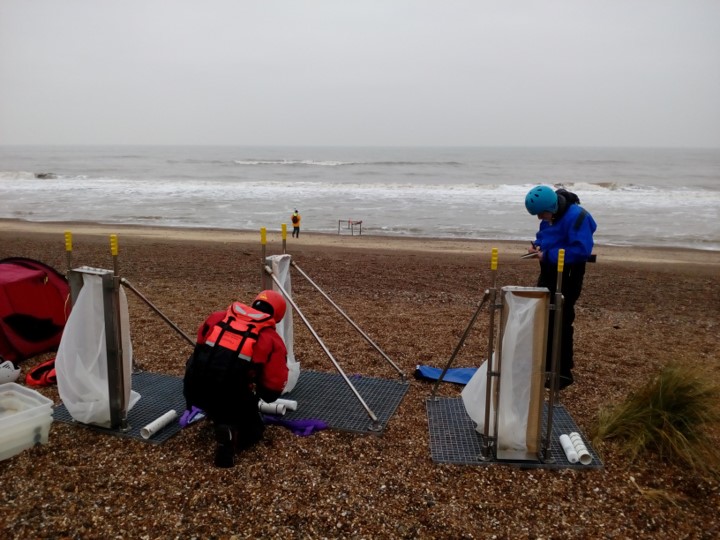Category:Portable streamer traps for longshore sediment transport measurement

In this category, we present a new portable streamer trap to measure point-Depth-Integrated Longshore Sediment Transport on mixed sand and gravel beaches.
Metadata
Summary
Also known as DIST, it is a portable depth-integrated streamer trap designed to measure the depth-integrated combined bed load and suspended longshore sediment transport on MSG beaches. The device consists of a polyester sieve cloth mounted into a rectangular holding frame. The stability of the device is achieved by gravity: the combined weight of the device and the operator, who is standing on and down-current of the device. The device has been tested in the field under moderate wave conditions at Minsmere, UK.
Highlights
- Measurement of the longshore sediment transport rate in the surf zone remains one of the great challenges in coastal engineering and coastal sciences.
- Streamer traps for sand beaches have proven useful in the past, but are not suitable for Mixed Sand and Gravel beaches.
- This category describes a portable depth integrated, streamer trap designed to measure the depth-integrated combined bed load and suspended longshore sediment transport on MSG beaches.
- The device has been tested in the field under moderate wave conditions at Minsmere, UK.
- Empirical efficiency of wave breaking and bed load are several orders of magnitude larger than for uniform fine sand values.
Technical specs
The streamer is made of 1.5 m2 of polyester sieve cloth (0.105 mm mesh), used to trap sediment from sand to gravel size (125 μm–64 mm). (Material larger than 64 mm will also be trapped, but can be easily removed, and in any case is extremely rare.) The sieve cloth has been shaped and sewn as an oblique rectangular pyramid (1,000 mm height), with a base of slightly larger dimensions than the streamer mouth (i.e. to be able to fit the streamer to the mouth), and the apex aligned with the center of one of the shorter sides of the rectangular base. The opening of the streamer that connects with the rectangular mouth is reinforced with a canvas hem. The streamer is mounted into the rectangular mouth frame with the plane made by the apex and the apex-aligned shorter side of the rectangle at the bottom. Streamer frames are secured on the rectangular mouth by bearing pressure created by stainless steel plates on each side of the mouth. Locking pressure is achieved by tightening a number of wing nuts along each side of the frame. The device has been designed to be quickly assembled and dismantled in the field.
History
DIST was first developed in 2020[1] with the aim to investigate the field performance of the device under moderate wave conditions (i.e. wave heights less than 1 m). To test the performance of the device, we compare measured to simulated rates using the depth-integrated and wave averaged cross shore numerical model CSHORE[2]. During the experiment, offshore wave forcing was measured by a directional wave buoy located about 4 km seaward of the study site. Current velocity and water levels were measured with an Acoustic Doppler Velocimeter (ADV) and a pressure sensor anchored to a fixed rig, which was well within the surf zone during the full tidal cycle. A pressure sensor was also attached to the portable streamer trap to provide information relative to water depth and water surface elevation at the trap location.
References
- ↑ Payo, Andres, Humphrey Wallis, Michael A. Ellis, Andrew Barkwith, and Timothy Poate. "Application of portable streamer traps for obtaining point measurements of total longshore sediment transport rates in mixed sand and gravel beaches." Coastal Engineering 156 (2020): 103580. [1]
- ↑ Kobayashi, Nobuhisa. "Coastal sediment transport modeling for engineering applications." Journal of Waterway, Port, Coastal, and Ocean Engineering 142.6 (2016): 03116001.[2]
Please note that others may also have edited the contents of this article.
|
This category currently contains no pages or media.